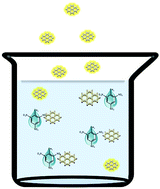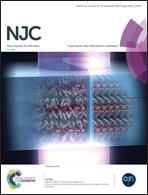Fabrication of amine and imine-functionalized isoreticular pillared-layer metal–organic frameworks for the highly selective detection of nitro-aromatics†
Abstract
Chemical sensors for the rapid and selective detection of explosives such as 2,4,6-trinitrotoluene (TNT) are very important. In order to find efficient sensors with enhanced performance for nitro-aromatics, a series of IRMOFs with different pillaring ligands but the same network topology was examined. The fluorescence sensing ability of these compounds towards nitrobenzene (NB), 1,3-dinitrobenzene (1,3-DNB), 2,4-dinitrotoluene (2,4-DNT) and 2,4,6-trinitrotoluene (TNT) was investigated. These compounds have great potential for the detection of TNT. The limit of detection (LOD) for TNT is 112, 261, 833 and 1070 nM for TMU-6(L1), TMU-21(L2), TMU-6(RL1) and TMU-21(RL2), respectively. The LOD of TMU-21(RL2) is among the highest values reported in the literature for sensing TNT. The results highlight both the importance of functionality on the pillaring ligands as well as the hydrophilic/hydrophobic nature of the framework pores for the potential of MOFs for the detection of nitro-aromatics.



 Please wait while we load your content...
Please wait while we load your content...